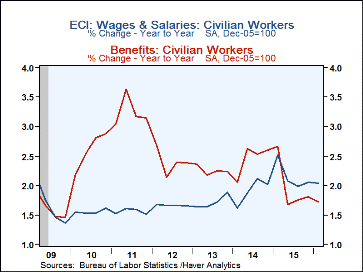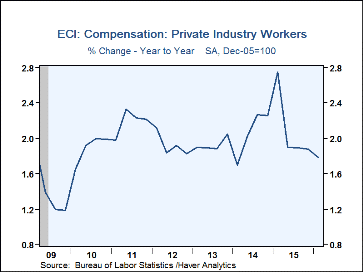 Global| Apr 29 2016
Global| Apr 29 2016U.S. Employment Cost Index Remains Firm
by:Tom Moeller
|in:Economy in Brief
Summary
The employment cost index for civilian workers increased 0.6% (1.9% y/y) during Q1'16 following a 0.5% rise. The latest gain was as expected in the Action Economics Forecast Survey. Wages increased 0.7% (2.0% y/y) after a 0.5% rise, [...]
The employment cost index for civilian workers increased 0.6% (1.9% y/y) during Q1'16 following a 0.5% rise. The latest gain was as expected in the Action Economics Forecast Survey. Wages increased 0.7% (2.0% y/y) after a 0.5% rise, and benefits rose 0.5% (1.7% y/y) following two quarters of 0.6% gain.
The employment cost index for private industry workers improved 0.6% in Q1'16 (1.8% y/y), following an unrevised 0.5% rise during Q4. The index for the professional & business services sector posted a stable 0.6% gain, though the y/y increase moderated significantly to 1.1%. Trade, transportation & utility workers compensation strengthened 1.2% (2.8% y/y) following a 0.1% gain. Information sector compensation rose 0.7% (-2.1% y/y) after a 0.3% rise. Education & health services workers realized 0.4% growth (1.6% y/y) after a 0.4% increase. Factory workers compensation rose 0.5% (2.3% y/y) and construction workers saw 0.5% growth (2.4% y/y). In the public sector, state & local government workers compensation rose 0.5% (2.5% y/y) following a 0.8% jump.
Wages & salaries in private industry rose 0.7% (2.1% y/y) following a 0.6% increase. Workers in professional & business services realized 0.9% wage growth (1.3% y/y) and that followed a moderated 0.6% increase. Trade, transportation & utility wages jumped 1.0% (2.5% y/y) after a 0.1% rise. Information sector wages strengthened 1.2% (2.7% y/y) after a 0.4% gain. Wages in leisure & hospitality rose 1.1% (2.3% y/y) following a 0.6% increase. Factory sector wages grew a fairly steady 0.6% (2.6% y/y), and construction wages advanced a moderated 0.5% (2.6% y/y). Wages for state & local government workers improved 0.4% (1.8% y/y) after a 0.5% gain.
Benefits of private industry workers grew 0.5% (1.2% y/y) following a 0.4% increase. Sales & office workers realized a 1.1% jump (2.4% y/y) after a 0.5% rise. Workers in service occupations saw a 0.6% increase (1.9% y/y) and management & professional workers saw no change (0.3% y/y). Factory sector workers benefits rose 0.4% (1.9% y/y) after a 0.8% jump. State & local government worker benefits increased a lessened 0.6%. The y/y gain of 3.4% was a bit higher than during the prior six years. These increases were down, however, versus the 6.0% growth of the prior decade.
The employment cost index figures are available in Haver's USECON database. Consensus estimates come from the Action Economics survey, carried in Haver's AS1REPNA database.
Tom Moeller
AuthorMore in Author Profile »Prior to joining Haver Analytics in 2000, Mr. Moeller worked as the Economist at Chancellor Capital Management from 1985 to 1999. There, he developed comprehensive economic forecasts and interpreted economic data for equity and fixed income portfolio managers. Also at Chancellor, Mr. Moeller worked as an equity analyst and was responsible for researching and rating companies in the economically sensitive automobile and housing industries for investment in Chancellor’s equity portfolio. Prior to joining Chancellor, Mr. Moeller was an Economist at Citibank from 1979 to 1984. He also analyzed pricing behavior in the metals industry for the Council on Wage and Price Stability in Washington, D.C. In 1999, Mr. Moeller received the award for most accurate forecast from the Forecasters' Club of New York. From 1990 to 1992 he was President of the New York Association for Business Economists. Mr. Moeller earned an M.B.A. in Finance from Fordham University, where he graduated in 1987. He holds a Bachelor of Arts in Economics from George Washington University.










